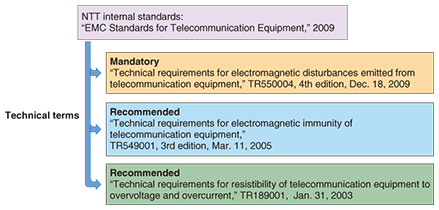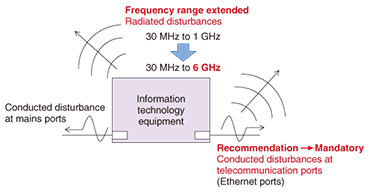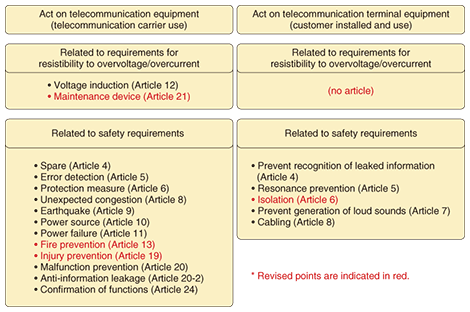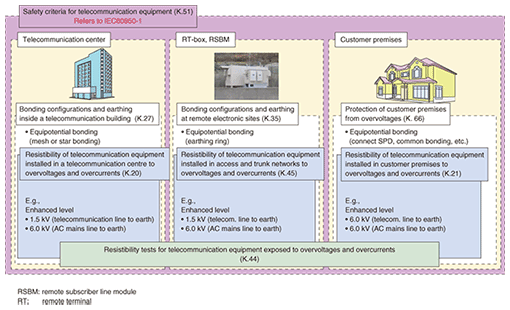 |
|||||||
|
|
|||||||
|
Feature Articles: Environment and Energy Technologies Toward a Green Society Vol. 9, No. 2, pp. 19–24, Feb. 2011. https://doi.org/10.53829/ntr201102fa3 Recent Activities Concerning NTT Technical Requirements for Electromagnetic CompatibilityAbstractIn this article, we describe the backgrounds of and present summaries of the revisions to the technical requirements for electromagnetic emission and resistibility to overvoltage and overcurrent. We also summarize the newly published technical requirements for electromagnetic emissions from lighting equipment installed in telecommunication centers.
1. IntroductionThe NTT Group has developed and maintains electromagnetic compatibility (EMC) requirements in order to develop and procure telecommunication equipment and systems that emit sufficiently small electromagnetic disturbances that they do not interfere with radio communication and other equipment and are not susceptible to electromagnetic disturbances. These requirements will help to create a good electromagnetic environment, which is a corporate social responsibility, continuously provide high-quality and reliable telecommunication services to customers, and cut maintenance costs. The EMC requirements in the NTT Group are the “EMC Standards for Telecommunication Equipment” and “Technical Requirements” (TRs) [1], as shown in Fig. 1. The EMC Standards for Telecommunication Equipment describe how we control the EMC characteristics of telecommunication equipment used to provide our telecommunication services and our sales, leases, and rentals to customers. The TRs are distributed to telecommunication equipment manufacturers and venders to notify them of our minimum requirements for EMC. Current TRs are “Technical requirements for electromagnetic disturbances emitted from telecommunication equipment (TR550004)”, “Technical requirements for electromagnetic immunity of telecommunication equipment (TR549001)”, and “Technical requirements for resistibility of telecommunication equipment to overvoltage and overcurrent (TR189001)”. These TRs are cited in the specification documents for procuring telecommunication equipment and systems. The requirements in TR550004 are mandatory, while those in TR549001 and TR189001 are currently recommendations. These TRs can be obtained from the International Procurement Homepage.
In this article, we describe the revisions to TR550004, which was amended in December 2009, summarize TR189001, which was scheduled to be amended in 2010, and describe the technical requirements for electromagnetic disturbances emitted from lighting equipment installed in telecommunication centers, which will be published soon. 2. Revision of TR5500042.1 BackgroundThe electromagnetic disturbances emitted from telecommunication equipment in Japan are voluntarily controlled by the VCCI Council (VCCI) [2], which was formerly called the Voluntary Control Council for Interference by Information Technology Equipment, in cooperation with information technology equipment (ITE) manufacturers and telecommunication carriers. The NTT Group joined VCCI in August 1989 and complies with VCCI technical requirements, which are based on the international standard CISPR publication 22 published by the International Special Committee on Radio Interference (CISPR) in the International Electrotechnical Commission (IEC). CISPR 22 specifies the limits and measurement methods of radio disturbances from ITE. TR550004 must meet the VCCI technical requirements, CISPR 22, and other equivalent standards. The main radiation or propagation paths of electromagnetic disturbances are (1) printed patterns on circuit boards and wiring between the boards and (2) telecommunication, signal, and power lines. The emitted disturbances might interfere with radio communication systems, such as televisions (TVs) and radios, and other equipment. The electromagnetic disturbances emitted from telecommunication equipment have been becoming more wideband and high-frequency because the transmit signals are high-speed and high-capacitive and the clock frequency of telecommunication equipment such as Next Generation Network (NGN) equipment is increasing. To prevent interference, the electromagnetic disturbances radiated from telecommunication cables and the higher frequency should be reduced. For these purposes, international standardization organizations, such as CISPR, have been discussing limits and measurement methods of disturbances radiated from telecommunication cables. NTT Energy and Environment Systems Laboratories joined this discussion and proposed measurement methods. On the basis of these activities, we contributed to the revisions of CISPR 22 and VCCI technical requirements. As a result of these activities, new regulations on conducted disturbances at telecommunication ports and radiated disturbances from 1 to 6 GHz will be put into practice. 2.2 Summary of revisionsThe NTT Group revised TR550004 in December 2009 on the basis of the abovementioned external standards. The old version of TR550004 regulated the radiated disturbances from telecommunication equipment and the conducted disturbances at the mains AC power supply ports of the equipment. The revised TR550004 additionally regulates the conducted disturbances at telecommunication ports and the 1–6-GHz radiated disturbances from telecommunication equipment (Fig. 2).
CISPR 22 describes the limits and measurement methods of conducted disturbances at telecommunication ports. The NTT internal standards dealt with the limits of the recommendations because the measurement circuit specified in CISPR 22 edition 3 had technical problems. At this point, NTT Energy and Environment Systems Laboratories developed a new measurement circuit that resolved the technical problems and proposed it to CISPR. As a result, our measurement circuit was used as the international standard. Therefore, we changed the limits for conducted disturbances at telecommunication ports to mandatory regulation ones in TR550004. The limits for 1–6-GHz radiated disturbances have been added to our EMC requirements to protect radio systems, such as cell phones and wireless local area networks. We discussed the contents of TR550004 for revision within the EMC Liaison Group, which was joined by relevant departments of our operating company, i.e., NTT EAST, NTT WEST, NTT Communications, and NTT DOCOMO. The focus of the EMC Liaison Group is sharing information and resolving methods related to EMC issues and reflecting requests from these companies because EMC requirements may impact costs. 3. Revision of TR1890013.1 BackgroundThe Ministry of Internal Affairs and Communications’ plan to add requirements for overvoltage/current resistibility and safety to the Telecommunication Business Act was reported on July 28, 2009. These requirements aim to prevent problems related to lightning strikes, combustion, and so on. According to the report from the Information and Communications Council, the overvoltage/current resistibility requirements will be harmonized with those specified in the international K-series recommendations published by the International Telecommunication Union, Telecommunication Standardization Sector (ITU-T) (Fig. 3). Safety requirements will be harmonized with those specified in international standard IEC60950-1 published by IEC.
3.2 Summary of revisionsFollowing the above trend, NTT plans to revise TR189001 to specify technical requirements for resistibility of telecommunication equipment to overvoltage and overcurrent. Three important points must be considered.
There are several K-series recommendations such as K.20: Resistibility of telecommunication equipment installed in a telecommunication centre to overvoltages and overcurrents and K.44: Resistibility tests for telecommunication equipment exposed to overvoltages and overcurrents—Basic recommendation, as shown in Fig. 4. The resistibility requirements and test conditions are based on the TN power distribution system, a major power distribution system throughout the world specified in these recommendations. The neutral and protective earth conductors of the TN system are connected to earth at the same place, and the protective earth conductors are distributed with the power conductors so that the potential of the earth conductors is equivalent. This is called equipotential bonding. However, the TT power distribution system is used in Japan. Neutral conductors of the TT system are connected to earth at a single point, e.g., the transformer on a utility pole. Protective earth conductors are independently connected to the earth at another point, e.g., an outlet for connecting a washing machine.
There are three levels of overvoltage/current resistibility requirements in the K-series: basic, enhanced, and special. The basic level has the lowest requirements. Since the TT system is susceptible to the overvoltage/current caused by earthing conductors being separately connected to earth, a high resistibility level to the equipment used in Japan is necessary. According to K.44, if equipotential bonding cannot be achieved in the TT system, the special level, i.e., withstanding 10–13 kV overvoltage, shall be required for the equipment. However, it is difficult to achieve this resistibility level only by insulating the equipment, so external protective devices or surge protective devices (SPDs) implemented in the equipment are necessary. We must consider the adequate protection level to minimize the cost impact because such mitigation generally adds to the cost. Moreover, it is sometimes difficult to implement SPDs in equipment for lightning protection. For example, making a bridge over double insulation by using SPDs for lightning protection is not permitted by IEC60950-1 for safety reasons. In this case, both the special level specified in K.44 and the safety requirement in IEC60950-1 should be met simultaneously. If it is difficult to satisfy the special level, the enhanced level specified in K.21 and other documents should be required, giving preference to the safety requirements. If necessary, an external SPD must be attached to the equipment to satisfy the overvoltage/current resistibility and safety requirements. On the basis of the policy described above, we will revise the TR and propose that ITU-T and IEC discuss harmonizing the requirements specified in the K-series and IEC60950-1. 4. Publishing technical requirements for electromagnetic disturbances emitted from lighting systems installed in telecommunication centers4.1 BackgroundThe electromagnetic emission of fluorescent lights is currently low enough not to disturb the normal operation of telecommunication equipment, so these lights are used in telecommunication centers. To reduce energy consumption, a lighting system using light-emitting diodes (LEDs) is being considered for installation in the machine rooms of telecommunication centers. However, the emission limits of LED lighting systems are not specified in the current EMC requirements. 4.2 Summary of the TRTwo types of emission are considered when the limits of the electromagnetic emission from lighting systems are specified. One is the emission continuously emitted from the systems when they are illuminating, and the other is the transient emissions from the systems when they are turned on and off. The electromagnetic emission levels of rapid-start-type and low-noise-inverter-type fluorescent lights are almost the same. These lights are currently used in the machine rooms of telecommunication centers. This use is based on evaluation results for whether typical telecommunication equipment is disturbed by the emissions from the lights. Thus, limits equivalent to the electromagnetic emission level of the rapid-start-type fluorescent lights will be specified in the TR. However, to specify adequate emission limits, we must investigate increases in the emission level due to many of the same lighting systems being used simultaneously in a machine room. 5. ConclusionThis article describes recent activities of the NTT Group related to revising and publishing EMC technical requirements. The revised TR for electromagnetic emission (TR550004) has been in force since April 2010. The revised TR for resistibility to overvoltage/overcurrent (TR189001) and the new TR for electromagnetic emission from lighting systems installed in the machine rooms of telecommunication centers will be published by the end of fiscal year 2010. The NTT Group intends to maintain a good electromagnetic environment and provide high-quality and highly reliable telecommunication services by meeting EMC requirements. References
|
|||||||














